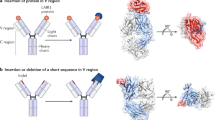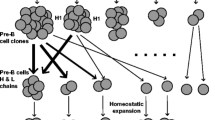Abstract
Observations suggesting the existence of natural antibody prior to exposure of an organism to the corresponding antigen, led to the natural selection theory of antibody formation of Jerne in 1955, and to the two signal hypothesis of Forsdyke in 1968. Aspects of these were not only first discoveries but also foundational discoveries in that they influenced contemporaries in a manner that, from our present vantage point, appears to have been constructive. Jerne’s later hypothesis (1971, European Journal of Immunology 1: 1–9), that antibody-like receptors on lymphocytes were selected over evolutionary time for reactivity with the major histocompatibility complex (MHC) antigens of the species, was a first, but it was incorrect, and was foundational only to the extent that it emphasized the need to explain the Simonsen phenomenon. Although easily construed as derivative of Jerne (1971), the affinity/avidity model of Forsdyke (1975, Journal of Theoretical Biology 52: 187–198), which predicted that cell-surface components, including MHC antigens, would restrict antigen-reactivity by somatically shaping lymphocyte repertoires, was actually an extension of the two signal hypothesis. While presenting a mechanism for the positive selection of lymphocyte repertoires, and explaining the Simonsen phenomenon, the affinity/avidity model was not foundational in that it had to be independently rediscovered. For science to advance optimally we must seek to close temporal gaps so that first discoveries are also foundational. Listening to young scientists may be part of the solution.
Similar content being viewed by others
References
Barber, B. 1961. “Resistance by Scientists to Scientific Discovery.” Science 134: 596–602.
Benecerraf, B. and McDevitt, H. 1972. “Histocompatibility-Linked Immune Response Genes.” Science 175: 273–279.
Bodmer, W.F. 1972. “Evolutionary Significance of the HLA System.” Nature 237: 139–145.
Brenner, S. and Milstein, C. 1966. “Origin of Antibody Variation.” Nature 211: 242–243.
Brent, L. 1997. A History of Transplantation Immunology. San Diego: Academic Press.
Bretscher, P. 2004. “Living with the Ups and Downs of the Two Signal Model.” Immunology and Cell Biology 82: 141–148.
Bretscher, P. and Cohn, M. 1968. “Minimal Model for the Mechanism of Antibody Induction and Paralysis by Antigen.” Nature 220: 444–448.
Burnet, F.M. 1959. The Clonal Selection Theory of Acquired Immunity. Cambridge: Cambridge University Press, pp. 64–66.
Cancro, M.P. and Kearney, J.F. 2004. “B Cell Positive Selection: Road Map to the Primary Repertoire?” Journal of Immunology 173: 15–19.
Claman, H.N., Chaperon, E.A. and Triplett, R.F. 1966. “Thymus-Marrow Cell Combinations: Synergism in Antibody Production.” Proceedings of the Society for Experimental Biology and Medicine 122: 1167–1171.
Claverie, J.M. and Kourilsky, P. 1986. “The Peptidic Self Model: A Reassessment of the Role of the Major Histocompatibility Complex Molecules in the Restriction of the T Cell Response.” Annales de l’Institute Pasteur-Immunologie 137D: 425–442.
Cock, A.G. and Forsdyke, D.R. 2008. Treasure Your Exceptions. The Science and Life of William Bateson. Cambridge: Cambridge University Press.
Cock, A.G. and Simonsen, M. 1958. “Immunological Attack on Newborn Chickens by Injected Adult Cells.” Immunology 1: 103–110.
Cohn, M. 1989. “History of Associative Recognition Theory.” R.E. Langman (au.), The Immune System: Evolutionary Principles Guide Our Understanding of this Complex Biological Defense System. San Diego: Academic Press, pp. xvii–xxvi.
Cohn, M. 1994. “The Wisdom of Hindsight.” Annual Reviews of Immunology 12: 1–62.
Doherty, M. and Robinson, M.J. 2004. “Some Early Trends in Immunology.” Trends in Immunology 25: 623–631.
Ehrlich, P. 1900. “On Immunity with Special Reference to Cell Life.” Proceedings of the Royal Society (London) 66: 424–448.
Eisen, H.N. 1966. “Learning and Memory in the Immune Response.” Cancer Research 26: 2005–2011.
Forsdyke, D.R. 1966a. “Response to Phytohaemagglutinin.” Lancet 287: 713.
Forsdyke, D.R. 1966b. “Nucleic Acid Changes During PHA-Induced Lymphocyte Transformation In Vitro and the Possible Relationship of this Phenomenon to Immune Processes In Vivo.” M.W. Elves (ed.), The Biological Effects of Phytohaemagglutinin. Oswestry: The R. Jones and A. Hunt Orthopaedic Hospital, pp. 115–123.
Forsdyke, D.R. 1967. “Quantitative Nucleic Acid Changes During PHA-Induced Lymphocyte Transformation In Vitro: Dependence of the Response on the PHA/Serum Ratio.” Biochemical Journal 105: 679–684.
Forsdyke, D.R. 1968. “The Liquid Scintillation Counter as an Analogy for the Distinction Between ‘Self’ and ‘Not-Self’ in Immunological Systems.” Lancet 291: 281–283.
Forsdyke, D.R. 1969a. “Impaired Activation of Thymus Lymphocytes by PHA.” Journal of Immunology 103: 818–823.
Forsdyke, D.R. 1969b. “A Theory of Immunity.” Journal of Theoretical Biology 25: 173–185.
Forsdyke, D.R. 1973a. “Serum Factors Affecting the Incorporation of [3H]thymidine by Lymphocytes Stimulated by Antigen: I. Serum Concentration.” Immunology 25: 583–596.
Forsdyke, D.R. 1973b. “Serum Factors Affecting the Incorporation of [3H]thymidine by Lymphocytes Stimulated by Antigen: II. Evidence for a Role of Complement from Studies with Heated Serum.” Immunology 25: 597–612.
Forsdyke, D.R. 1973c. “Serum Factors Affecting the Incorporation of [3H]thymidine by Lymphocytes Stimulated by Antigen: III. Evidence for a Role of Complement from Studies with Specific Complement Inhibitors.” Immunology 25: 613–619.
Forsdyke, D.R. 1975. “Further Implications of a Theory of Immunity.” Journal of Theoretical Biology 52: 187–198.
Forsdyke, D.R. 1980. “Lectin Pulses as Determinants of Lymphocyte Activation and Inactivation During the First Six Hours of Culture: Sequential Action of Concanavalin-A and Complement Cause Cell Lysis.” Canadian Journal of Biochemistry 58: 1387–1396.
Forsdyke, D.R. 1991. “Early Evolution of MHC Polymorphism.” Journal of Theoretical Biology 150: 451–456.
Forsdyke, D.R. 1995a. “The Origins of the Clonal Selection Theory of Immunity as a Case Study for Evaluation in Science.” Federation of American Societies for Experimental Biology Journal 9: 164–166.
Forsdyke, D.R. 1995b. “Jerne and Positive Selection.” Immunology Today 16: 105.
Forsdyke, D.R. 2000. Tomorrow’s Cures Today? How to Reform the Health Research System. Amsterdam: Harwood Academic.
Forsdyke, D.R. 2005. “‘Altered-Self’ or ‘Near-Self’ in the Positive Selection of Lymphocyte Repertoires?” Immunology Letters 100: 103–106.
Gaudin, E., Hao, Y., Rosado, M.M., Chaby, R., Girard, R. and Freitas, A.A. 2004. “Positive Selection of B Cells Expressing Low Densities of Self-Reactive BCRs.” Journal of Experimental Medicine 199: 843–853.
Gowans, J.L. and Uhr, J.W. 1966. “The Carriage of Immunological Memory by Small Lymphocytes in the Rat.” Journal of Experimental Medicine 124: 1017–1030.
Harrison, E. 1987. “Whigs, Prigs and Historians of Science.” Nature 329: 213–214.
Hilschmann, N. and Craig, L.C. 1965. “Amino Acid Sequence Studies with Bence-Jones Proteins.” Proceedings of the National Academy of Sciences of the United States of America 53: 1403–1409.
Huseby, E., Kappler, J. and Marrack, P. 2004. “TCR-MHC/Peptide Interactions: Kissing Cousins or a Shotgun Wedding?” European Journal of Immunology 34: 1243–1250.
Janeway, C.A. 2001. “How the Immune System Works to Protect the Host from Infection: A Personal View.” Proceedings of the National Academy of Sciences of the United States of America 98: 7461–7468.
Jerne, N.K. 1955. “The Natural Selection Theory of Antibody Formation.” Proceedings of the National Academy of Sciences of the United States of America 41: 849–857.
Jerne, N.K. 1966. “The Natural Selection Theory of Antibody Formation; Ten Years Later.” J. Cairns, G.S. Stent and J.D. Watson (eds.), Phage and the Origins of Molecular Biology. Cold Spring Harbor, NY: Cold Spring Harbor Laboratory Press, pp. 301–312.
Jerne, N. K. 1969. “The Generation of Self-Tolerance and of Antibody Diversity.” Report of Scientific Group on Factors Regulating the Immune Response. Geneva: World Health Organization, 1–6 September, pp. 1–14.
Jerne, N.K. 1970. “Generation of Antibody Diversity and Self Tolerance – A New Theory.” R.T. Smith and M. Landy (eds.), Immune Surveillance. New York: Academic Press, pp. 343–363.
Jerne, N.K. 1971. “The Somatic Generation of Immune Recognition.” European Journal of Immunology 1: 1–9.
Jerne, N.K. 1974. “Towards a Network Theory of the Immune System.” Annales d’Immunologie 125C: 373–389.
Lederberg, J. 1959. “Genes and Antibodies. Do Antigens Bear Instructions for Antibody Synthesis of Do They Select Cell Lines that Arise by Mutations?” Science 129: 1649–1653.
Lederberg, J. 1994. “The Landmark Interviews. The Genetic Control of Antibody Synthesis.” Journal of NIH Research 6: 72–80.
Lo, D. and Sprent, J. 1986. “Identity of Cells that Imprint H-2-Restricted T-Cell Specificity in the Thymus.” Nature 319: 672–675.
Marrack, P. and Kappler, J. 1987. “The T Cell Receptor.” Science 238: 1073–1079.
Matzinger, P. 1993. “Why Positive Selection?” Immunological Reviews 135: 81–117.
Medawar, P.B. 1963. “Concluding Remarks.” A. Bussard (ed.), Acquired or Natural Immune Tolerance Towards Defined Protein Antigens. New York: Academic Press, p. 475.
Mendel, G.J. 1865. “Versuche über Pflanzenhybriden.” Verhandlung des naturforschenden Vereines in Brünn 4: 3–47.
Miller, J.F.A.P. 1961. “Immunological Function of the Thymus.” The Lancet 278: 748–749.
Milthorp, P. and Forsdyke, D.R. 1970. “Inhibition of Lymphocyte Activation at High Ratios of Con A to Serum Depends on Complement.” Nature 227: 1351–1352.
Mitchison, N.A. 1964. “Induction of Immunological Paralysis in Two Zones of Dosage.” Proceedings of the Royal Society, Series B, Biological Sciences 161: 275–292.
Nisbet, N.W., Simonsen, M. and Zalenski, M. 1969. “The Frequency of Antigen-Sensitive Cells in Tissue Transplantation. A Commentary on Clonal Selection.” Journal of Experimental Medicine 129: 459–467.
Nowell, P.C. 1960. “Phytohaemagglutinin: An Initiator of Mitosis in Cultures of Normal Human Leukocytes.” Cancer Research 20: 462–466.
Podolsky, S.H. and Tauber, A.I. 1997. The Generation of Diversity. Clonal Selection Theory and the Rise of Modern Immunology. Cambridge, MA: Harvard University Press.
Porter, R.R. 1958. “Separation and Isolation of Fractions of Rabbit Gamma-Globulin Containing the Antibody and Antigenic Combining Sites.” Nature 182: 670–671.
Radick, G. 2008. “Focus: Counterfactuals and the Historian of Science. Introduction: Why What if?” Isis 99: 547–551.
Roomp, K. and Domingues, F.S. 2011. “Predicting Interactions Between T Cell Receptors and MHC-Peptide Complexes.” Molecular Immunology 48: 553–562.
Scott-Browne, J.P., White, J., Kappler, J.W., Gapin, L. and Marrack, P. 2009. “Germline-Encoded Amino Acids in the αβ T-Cell Receptor Control Thymic Selection.” Nature 458: 1043–1046.
Simonsen, M. 1990. “Alloreactive T Cells.” Scandinavian Journal of Immunology 32: 565–575.
Söderqvist, T. 1994. “Darwinian Overtones: Niels K. Jerne and the Origin of the Selection Theory of Antibody Formation.” Journal of the History of Biology 27: 481–529.
Söderqvist, T. 2003. Science as Autobiography. The Troubled Life of Niels Jerne. New Haven: Yale University Press.
Söderqvist, T. and Stillwell, C. 1999. “Essay Review: The Historiography of Immunology is Still in Its Infancy.” Journal of the History of Biology 32: 205–215.
Sprent, J. and Webb, S.R. 1987. “Function and Specificity of T Cell Subsets in the Mouse.” Advances in Immunology 41: 39–133.
Sprent, J., Lo, D., Gao, E.K. and Ron, Y. 1988. “T-Cell Selection in the Thymus.” Immunological Reviews 101: 173–190.
Tauber, A. 2010. “Review of Arthur M. Silverstein’s A History of Immunology, and Ed Cohen’s A Body Worth Defending.” Isis 101: 636–637.
Wen, L., Brill-Dashoff, J., Shinton, S.A., Asano, M., Hardy, R.R. and Hayakawa, K. 2005. “Evidence of Marginal-Zone B Cell Positive Selection in Spleen.” Immunity 23: 297–308.
Wigzell, H. 1984. “Physiology or Medicine 1984.” J. Lindsten (ed.), Nobel Lectures, Physiology or Medicine 1981–1990. Singapore: World Scientific Publishing Co., 1993, pp. 203–208.
Zinkernagel, R.M. and Doherty, P.C. 1974. “Restriction of in vitro T Cell-Mediated Cytotoxicity in Lymphocytic Choriomeningitis with a Syngeneic or Semiallogeneic System.” Nature 248: 701–702.
Zinkernagel, R.M. and Doherty, P.C. 1997. “The Discovery of MHC Restriction.” Immunology Today 18: 14–17.
Zuckerman, H. and Lederberg, J. 1986. “Post-Mature Scientific Discovery.” Nature 324: 629–631.
Author information
Authors and Affiliations
Corresponding author
Additional information
Queen’s University hosts my theoretical immunology webpages where some of the cited references, including that of Ehrlich, may be found (http://post.queensu.ca/~forsdyke/theorimm.htm).
Rights and permissions
About this article
Cite this article
Forsdyke, D.R. Immunology (1955–1975): The Natural Selection Theory, the Two Signal Hypothesis and Positive Repertoire Selection. J Hist Biol 45, 139–161 (2012). https://doi.org/10.1007/s10739-011-9274-8
Published:
Issue Date:
DOI: https://doi.org/10.1007/s10739-011-9274-8




